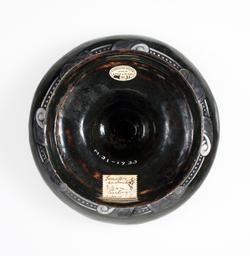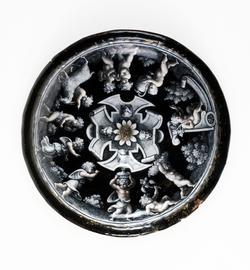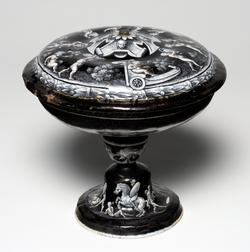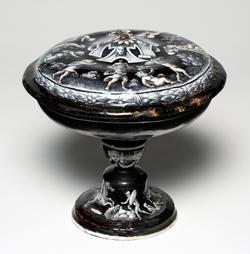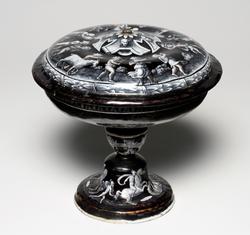Current Location: In storage
Maker(s)
Enameller:
Court dit Vigier, Jean I
Enameller:
Reymond, Pierre
Enameller:
Pénicaud, Jean III
(Possibly)
Entities
Categories
Description
Copper, enamelled en grisaille and gilded
Copper, enamelled in grisaille with flesh pink on a black ground, appearing very dark manganese-brown at the edges. The hemispherical bowl of the cup is supported on a vase-shaped knop on top of a bell-shaped circular foot. The low domed cover has a flange round the edge, and a raised central area with a replacement finial in the form of a horizontal silver (?) male mask. This is held in position on the underside by a lump of red sealing wax. The interior of the cup is decorated with the Creation of Adam, surrounded by a broad border of gold arabesques on a black ground. God stands on the right. He is bearded and crowned and wears a voluminous long gown. He extends his left hand towards the nude figure of Adam lying on the ground to the left. In the landscape background there are hills and a lake with three sea monsters in it; trees on either side behind the figures; and between them, many animals, including oxen, a pelican, a lion, a camel, a goat, a rabbit, and a cat stalking a mouse, and, on the right of God, a stag and a hind. The underside of the bowl is decorated with a radiating design of four grotesque masks, curling strapwork, swags and beading. The initials '.I.C.' are painted below one mask on the strapwork. Round the rim there is an egg and tongue border. The vase-shaped knop is decorated with three female masks and serrated swags, with a white band above, and on the foot, is a battle scene al antica, with nude warriors on foot and on horseback. The outer edges of the foot and rim are white.
The cover (a replacement) is decorated on the exterior with a central flowerhead surrounded by four leonine masks on curling strapwork, around which is a continuous procession of revelling putti wearing vine wreaths in their hair. One is seated in a chariot, the next holds a ewer, two walk together behind another accompanied by a goat, two skip along behind a trumpet player, the next holds a large jar above his head, the next sits holding a vine branch and the last carries a basket of grapes above his head. The scene is encircled by a border of bound laurel, and on the flange, remnants of a gilded border, no longer legible. The underside is decorated with a radiating design of four winged putto's heads linked by swags over strapwork surrounded by gilt arabesques, and remnants of a gilded guilloche border.
Notes
History note: Cup: uncertain before Alfred Aaron de Pass (1861–1952), Cliffe House, near Falmouth. Cover, probably Andrew Fountaine IV (1808–73) but not in the Catalogue of the Fountaine sale of 1884. The Hon. W.F.B. Massey-Mainwaring, M.P. (1845–1907), and the Hon. Mrs Massey-Mainwaring; Robinson & Fisher, 6 June, 1904, lot 81; sold to Lichfield.
Legal notes
Given by Alfred A. de Pass in memory of his son Crispin (d. 1918)
Measurements and weight
Height: 19.2 cm
Acquisition and important dates
Method of acquisition: Given
(1933)
by
de Pass, Alfred A.
Dating
16th Century, second half
Circa
1570
CE
-
Before
1580
CE
Note
Standing cups with tall stems and wide shallow bowls were an Italian form of drinking vessel for wine which was being made in silver in north west Europe by the early 1530s. Known as tazze in Italy, the were described as coupes or coupes-tasses in France. Some of them were provided with covers, and the larger examples may have been used as stands for sweetmeats rather than for drinking. The earliest Limoges enamel examples, date from the mid 1530s. Substantial numbers were produced there after 1540 in the workshops of Léonard Limosin, Pierre Reymond, and Pierre Courteys. The earliest fully signed by Jean Court dit Vigier is dated 1555, and a year later he signed another bearing the arms of Mary Stuart, Queen of Scots, who was to marry the Dauphin in 1558. After this most of the marked cups from his workshop were initialled 'I.C.', and some scholars consider that not all of them were enamelled by the same hand.
Most of the cups were decorated inside the bowl with a scene from classical mythology or the Old Testament, and the outside of the covers with processions of deities or putti, scenes from the story of Adam and Eve, or medallions enclosing profile heads. The scene on the interior of this example was based on Bernard Saloman’s woodcut illustration of the 'Creation of Adam' in Claude Paradin's 'Quadrins historique de la bible', Lyon 1553 or later editions of 1555 or 1560, but differs from it in several details. The introduction of hares in the background suggests that the enameller was also influenced by Etienne Delaune’s 'Creation of the World' and 'Creation of Adam' in which hares are depicted. These formed part of a series of prints of the story of Adam and Eve which were published in 1569, and also occur on the exterior of the covers of several tazze with the Creation of Adam or the Temptation in the bowl, indicating that they date from about 1570 or later. For example, a pair of cups in the Green Vaults at Dresden (Inv. III, 15 and 16), which are initialled I.C. and attributed to Jean Court. It therefore seems likely that the original cover of the Fitzwilliam's example was decorated in the same way, and that the cup was made after about 1570 rather than in the late 1550s. The stem and foot have been joined to the bowl, and appear to be by a different maker, possibly Jean III Pénicaud or Pierre Pénicaud.
The present cover, probably enamelled a few years earlier by Pierre Reymond, bears an incised mark which indicates that it had been in the Fountaine Collection in Norfolk, and with a different cup, decorated inside with the Judgement of Solomon, formed lot 128 when that collection was sold by Christie's in 1884. It was bought by the Hon. W.F.B. Massey-Mainwaring, and in 1888 was among over 2,900 objects lent by him and his wife to the Bethnal Green Museum. At some point, possibly before the loan, the cup was paired with a different cover, and in 1904 when part of the collection was sold, the cover formed lot 81 and the cup with its different cover formed lot 82. The cover was bought by the London dealer, Litchfield, and at an unknown date was acquired by Alfred A. De Pass, who gave it to the Fitzwilliam in 1933. It is not known if he already possessed the present cup and bought the cover to go with it, or if he acquired both items together.
School or Style
Renaissance
People, subjects and objects depicted
Components of the work
Decoration
composed of
enamel
( pink, white, black)
gold
Foot Of Cup
Diameter 10.5 cm
Rim Of Cup
Diameter 17.5 cm
Rim Of Cover
Diameter 19.5 cm
Cup
Height 15.5 cm
Materials used in production
Copper
Techniques used in production
Raising (metal forming process)
: Copper, raised, and enamelled en grisaille with pale pink and salmon-pink wash on a black ground, appearing very dark manganese-brown at the edges
Inscription or legends present
- Text: .I.C.
- Location: On underside of bowl of cup on strapwork
- Method of creation: Painted in black
- Type: Initials
Inscription present: narrow rectangular white paper label
- Text: 1240
- Location: On underside of cover
- Method of creation: Printed in black
- Type: Label
Inscription present: probably an f crossed or af and further to the right, 8
- Text: af joined or f 8
- Location: On rim of cover
- Method of creation: Scratched
- Type: Initial
Inscription present: rectangular paper label with serrated ends and bottom edge, where there is a red printed line; the date is written sideways to the other words
- Text: Limoges/enamel/by Jean/Courtrey/signed I.C/16 cent
- Location: On underside of foot of cup
- Method of creation: Hand-written in faded black ink
- Type: Label
Inscription present: oval paper label printed with the words inside an oval black border line
- Text: FITZWILLIAM MUSEUM/GIVEN BY/ALFRED a. DE PASS/1933 printed and 31 hand-written
- Location: On underside of base of cup
- Method of creation: Printed in black and hand-written in black ink
- Type: Label
References and bibliographic entries
Identification numbers
Accession number: M.31 & A-1933
Primary reference Number: 156452
Stable URI
Audit data
Created: Saturday 6 August 2011
Updated: Tuesday 29 April 2025
Last processed: Thursday 14 August 2025
Associated departments & institutions
Owner or interested party:
The Fitzwilliam Museum
Associated department:
Applied Arts
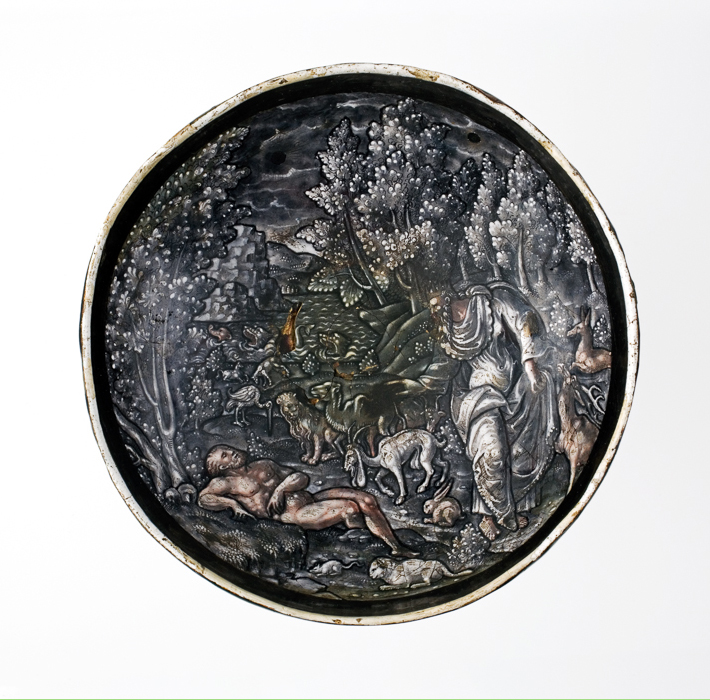
 IIIF Manifest
IIIF Manifest
